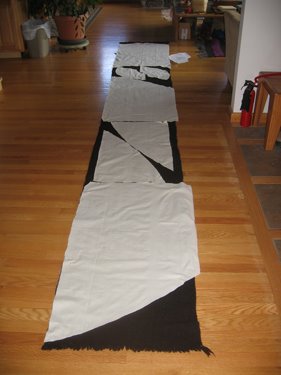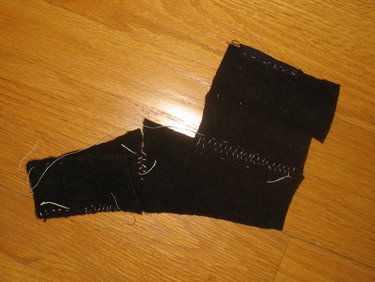Today, I started laying out the cloak pattern for my 18th-century Black Welsh cloak. Because my fabric is so much narrower than normal, I cut a long piece of muslin to 24 inches to match it. Then, I pieced the cloak pattern together out of that. I cut the muslin and laid it out on my Black Welsh fabric.

My first big problem is that my weaving is uneven. While the fabric is 24 inches wide on one edge, it’s only 22 inches for most of the length. I figured out a way to get the cloak body and shoulder cape out of my main piece of fabric, and while it’s not quite perfect, it’s close. I can cut the hood out of the sample piece I wove, so I think I can make it with nothing to spare.
My next problem is how to sew the pieces together. The original was a much finer fabric, and it was sewn in a contrasting thread with a 1/8 inch seam allowance. To test my sewing, I cut a small piece from my sample fabric and have been playing with various edge treatments. This is the sample I’ve been sewing on, using both thick hemp thread and thinner linen thread. The original was done with silk thread, but I don’t have any.

The bottom left edge is like the original. It is a pair of running seams with about 1/8 inch of seam allowance. This one makes a rather large welt because my fabric is so thick. I don’t think it will work, as the welts will make the cloak uncomfortable to wear.
Next over is a whip stitch. It has the same problems as the first option, and it’s hard for me to keep even. The middle seam is like a baseball: the raw edges are butt-ended and sewn in a herringbone style. This lies flat and seems sturdy enough, but it’s pulling because the weave is too loose.
I’m concerned that my seams will pull my threads out and they’ll fall apart. It is also totally inaccurate from a historical standpoint. The slantwise seam to the right is almost the same, but behind it I sewed some twill tape with a running seam on both sides to add strength and stability. The twill tape solves the stability problem, but also suffers from being inaccurate.
Above that is a seam you cannot see. It’s another version of the original seam along a selvedge edge. This almost works, because I wove a double warp on the selvedge, and I can sew just beyond the warp. For seams along a selvedge, I may just continue to do this. Along the top, I sewed a piece of the twill tape to encase the raw edge, and then I tried to sew it to itself as in the original. As you can see, I took it out because it made a huge lump. However, for the raw edges along the bottom and sides of the cloak, I think I’ll use it. It should work to bind them.
I have a lot of questions for anyone who hand-sews:
- Are there any other ways to attach two thick pieces of fabric together that I’ve missed?
- What do you think of the various options I’ve tried so far?
- Which ones should I use, and why?
- Should I stick with accurate contrasting thread and inaccurate stitching, or should I try to hide the inaccurate stitches by using black thread?
I tried machine sewing, but it didn’t turn out well. My fabric is too loosely woven, and it’s too thick for my machine to work properly with it.
Any and all suggestions are welcome!
